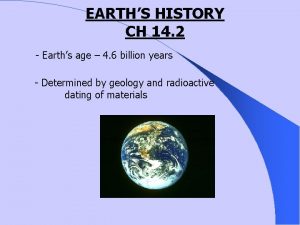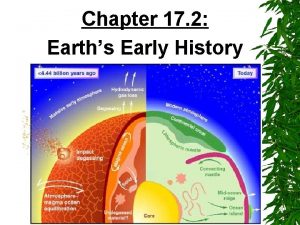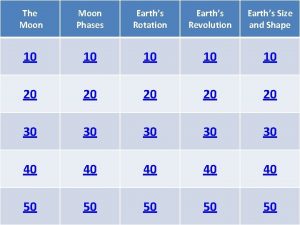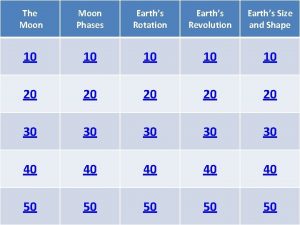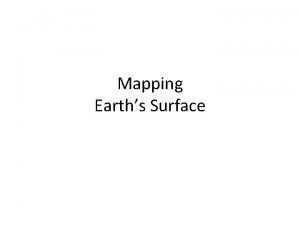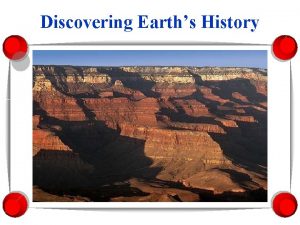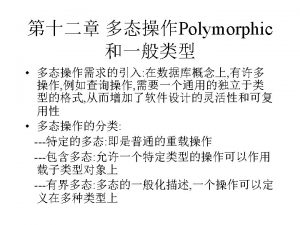Chapter 17 2 Earths Early History Age of
















- Slides: 16

Chapter 17. 2: Earth’s Early History

Age of the Earth It is estimated that the Earth is 4. 6 billion years old – Theories of how the Earth was “born” vary (IE – the Big Bang Theory) – Elements arranged themselves according to density Least dense make up the atmosphere, most dense make up the core

Earth’s Early Atmosphere Earth’s early atmosphere probably contained hydrogen cyanide, carbon dioxide, carbon monoxide, nitrogen, hydrogen sulfide, and water – All toxic gases except the water

The Early Earth 4 billion years ago the first solid rocks formed 3. 8 billion years ago that the Earth was cool enough to have liquid water – So this is when the first oceans formed

Earth BEFORE oceans formed Characteristics of Earth before oceans formed: ØComets and asteroids ØVolcanic activity ØAtmosphere of poisonous gas

Why do you think oceans did not exist on Earth 4 billion years ago? Water was a gas! Because Earth was very hot!

Formation of Organic Molecules Early atmosphere allowed the formation of organic molecules – because it DID NOT have oxygen – Would not form in today’s atmosphere Oxygen is too reactive Bacteria would eat the molecules

Miller and Urey Stanley Miller and Harold Urey attempted to answer whether Organic molecules could have formed before life was present. Filled an enclosed flask with a mixture of gases and water to simulate the Earth’s Atmosphere! Used electrodes to produce a Spark that simulates lightning!

Miller and Urey made sure no microscopic life existed in this experiment. Why? They had to make sure the original simple substances they were testing were the ONLY possible source for the creation of organic molecules.

The Results from Miller and Urey Amino acids began to form after a couple days. This mixture of amino acids and other organic compounds showed us that molecules necessary for life could have risen from simple compounds present on early Earth without life.

The First Cells Thought to have originated 200 -300 million years after oceans formed. Why? Because the presences of liquid water was necessary for first life. Earliest cells called proteinoid microspheres were created when organic molecules became trapped in bubbles Ø Not alive but have some characteristics of living cells Ø They had SELECTIVELY PERMEABLE MEMBRANES.

Oxygen-Free Life Forms The first life forms are thought to have evolved in oxygen free environments approximately 3. 5 billion years ago First organisms on Earth were most like today’s BACTERIA Photosynthetic organisms evolved in the oceans approximately 2. 2 billion years ago Started pumping oxygen into the atmosphere

Endosymbiotic Theory Belief is that eukaryotes formed approx. 2 billion years ago from COMMUNITIES of PROKARYOTES. – Prokaryotes “moved into” prokaryotic cells Created a symbiotic relationship – One group was able to use oxygen to make ATP Mitochondria – One group was able to use light to make sugars Chloroplasts


Evidence of the Endosymbiotic Theory Membranes of mitochondria and chloroplasts are similar to that of freeliving prokaryotes Mitochondria and chloroplasts have – DNA similar to bacterial DNA – Ribosomes similar to those of bacteria – Reproduce by binary fission

Sexual Reproduction The use of sexual reproduction by early organisms allowed evolution to occur at a much quicker rate – More gene shuffling
 Earths early atmosphere contained
Earths early atmosphere contained Iron age bronze age stone age timeline
Iron age bronze age stone age timeline Iron age bronze age stone age timeline
Iron age bronze age stone age timeline The earths layer foldable
The earths layer foldable Earths roation
Earths roation Whats earths moon called
Whats earths moon called Biome near the equator
Biome near the equator What is the most abundant element on earth
What is the most abundant element on earth Plasticity in earth's layers
Plasticity in earth's layers Whats earths moon called
Whats earths moon called What is earths thickest layer
What is earths thickest layer The earths layer foldable
The earths layer foldable Earths major crustal plates
Earths major crustal plates Earths orbit seasons
Earths orbit seasons Brown earth soil profile
Brown earth soil profile Earths physical features
Earths physical features Earths honey
Earths honey



















